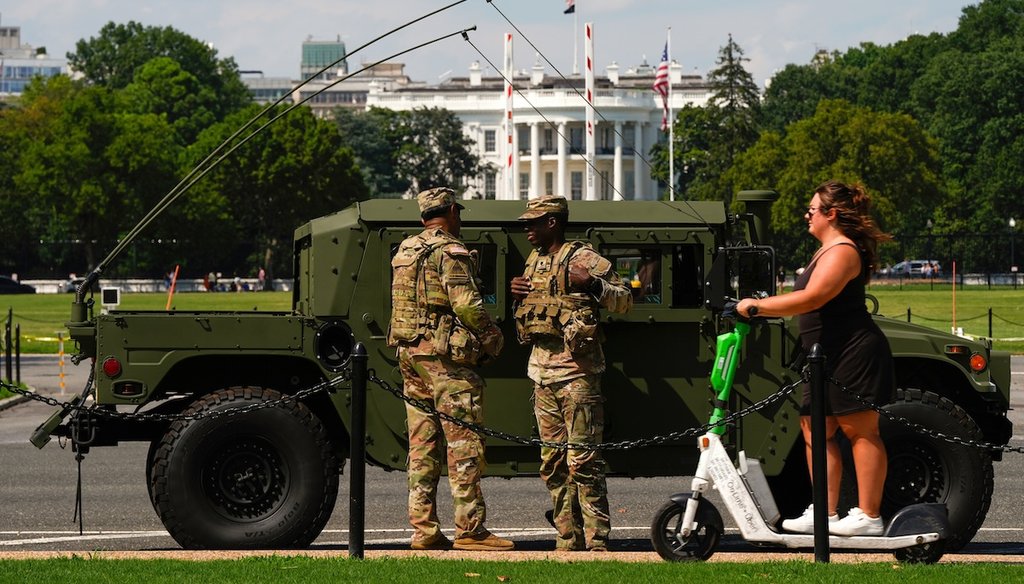
The Trump administration criticized Washington, D.C., crime statistics in response to pushback to the president’s deployment of the National Guard to the nation’s capital.
Homicide and carjacking rates in Washington, D.C., are declining, but Trump administration officials say those crime rates don’t tell the whole story. In an episode of the Benny Show, hosted by conservative activist Benny Johnson, U.S. Attorney for the District of Columbia Jeanine Pirro said, “I guarantee you there’s 25 to 30% of the crime here that’s not even being reported.”
Stephen Miller, White House deputy chief of staff, called crime stats “fake” in “big blue cities” in an Aug. 12 X post. “The real rates of crime, chaos & dysfunction are orders of magnitude higher,” Miller wrote.
When contacted for comment, White House spokesperson Abigail Jackson cited the May suspension of a district police commander accused of altering crime statistics. A Metropolitan Police Department spokesperson told PolitiFact that that district police commander is on administrative leave and declined to comment because of an active investigation.
Criminal justice experts agree that crime is underreported. That goes not only for Washington, D.C., but also throughout the U.S., said Janet Lauritsen, University of Missouri — St. Louis criminology and criminal justice professor emerita. But we know some of the extent of underreporting because one survey captures crime not reported to the police: the National Crime Victimization Survey or NCVS, Lauritsen said.
Sign up for PolitiFact texts
“I have seen no evidence that the rates of the public’s reporting of serious violence to the police are different in DC compared to any other area of the country, or that reporting rates have changed to a large degree over time,” Lauritsen said.
Adam Gelb, Council on Criminal Justice president and chief executive officer, said Pirro’s 25% to 30% figure likely underestimated the level of unreported crime. But there’s a difference between data and public perception, he said.
“The numbers can be falling and be high at the same time,” he said. “Just because a trend is headed in the right direction doesn’t mean it’s at a tolerable level.”
The U.S. Justice Department has two programs that measure the nation’s crime. One of them is the FBI’s Uniform Crime Reporting Program, which collects data reported to federal, state and local law enforcement. The other is the National Crime Victimization Survey, which is based on crimes both reported and not reported to law enforcement.
About 45% of violent crime is not reported to the police, according to 2023 NCVS data. Reasons for not reporting include fear of retribution, belief that police won’t be able to help and not wanting to get the offender in trouble.
Both sources present similar long-term crime trends, including rates of serious violent crime, motor vehicle theft and burglary, according to a June 2025 article by the Council on Criminal Justice. Differences in their methodology occasionally show disparate pictures of nationwide crime. Still, experts say the differences don’t result from inaccuracy.
NCVS measures crimes not reported to law enforcement
The NCVS survey, launched in 1973, is conducted annually by the Census Bureau, collecting information on crime victims through a household survey. Data covers nonfatal crimes and household property both reported and not reported to police, including rape, sexual assault, robbery, simple assault, larceny, burglary and theft. The NCVS excludes homicides, arson, commercial crimes and crimes against children under age 12, which the UCR includes.
The survey covers about 240,000 people ages 12 and older in 150,000 households.
In its questionnaire, the NCVS gathers details about the offender, characteristics of the crime, why it was or wasn’t reported to the police and victims’ experiences with the criminal justice system.
Because the NCVS samples only a portion of the U.S. population, the data is weighted to compensate for nonresponses and design flaws to ensure the results represent the nation.
Around 45% of violent crimes are reported to police, according to latest NCVS data
The UCR’s data comes from federal, state and local law enforcement agencies. Police voluntarily report their known and recorded crime data to the FBI, which then aggregates and analyzes this information. That doesn’t include unreported crimes.
The NCVS aims to remedy these gaps by collecting information on how many crimes go unreported, why victims didn’t go to the police and whether they sought resources from victim service agencies.
The latest NCVS data from 2023 showed that victims reported 44.7% of violent crimes to police. In urban areas, the reporting rate was 38%, lower than the national average.
Gelb said the NCVS helps understand the true total volume of crime. “It serves as an independent barometer that can help us understand crime through a different lens,” he said.
NCVS does not capture responses from people who are homeless, on military bases, in prisons, jails or nursing homes.
Other sources such as the Council on Criminal Justice, the University of Chicago’s Live Crime Tracker, the Gun Violence Archive, and the Centers for Disease Control and Prevention provide additional crime data, Gelb said.
A 2025 Council on Criminal Justice analysis shows even though these methodologies sometimes produce differing conclusions about crime, they typically show similar long-term trends.
Both show that serious violent crimes and burglary rates declined from 1993 to 2023. Trends in motor vehicle theft during the same time period were similar between the two sources; they began increasing after 2015.
The most common crimes — lower level offenses, such as simple assault — are the least likely to be reported to the police, according to the Council on Criminal Justice.
